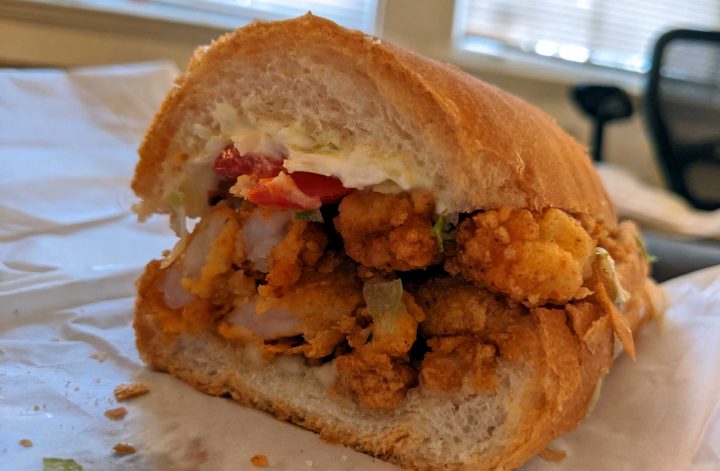Rumors spreading about the imminent death of the po-boy have been greatly exaggerated. Local foodies have been all a-buzz, venting on Facebook or Twitter about a seemingly insignificant burst of fast food restaurants moving in on neighborhood territory and “threatening the integrity of our local cuisine.” Dismayed cries filled cyberspace recently when national, fast-food chains like Smashburger was rumored to be filling a spot on Magazine or when Saints’ quarterback Drew Brees used his considerable star-power to convince city council to allow him to open a Jimmy John’s Gourmet Sandwiches on Maple in the Riverbend. Orleans Parish members shout their disdain with comments like “Keep ’em in Metairie” or “Eat a po-boy, not a sub!”
Despite the backlash, those national fast-food chains (including Five Guys on Carrollton Avenue and Pei Wei in Mid-City) will undoubtedly open, serve food and be frequented by many New Orleanians. Can our small market support all of these new restaurants? Will our favorite Mom & Pop’s suffer from the competition? Before the levee failures, there were approximately 800 restaurants in the Greater New Orleans Area. Now there are over 1300 and more are opening every day. How can a population that has been considerably reduced from a man-made disaster (or two…thanks BP!), possibly support so many eateries?
Frank Brigtsen, chef and owner of Brigtsen’s Restaurant in the Riverbend, has his ear to the ground and is moved by controversy over the gradual loss of Louisiana’s culturally unique cuisine. As a businessman, Frank is a believer in free-enterprise and growth, but he recognizes that our city has it’s own, unique complications.
“One of the main things New Orleanians try to do is sort of balance the charm of old New Orleans with what we need to have for the future to grow. So, there’s always a struggle when a new business tries to open in an old neighborhood.” he says knowingly. “As a city, we have to find a way to embrace growth and progress, while still maintaining the unique and quirky charm of New Orleans. That is never an easy thing, but its something we all have to do.”
Owning his own neighborhood eatery, Chef Brigtsen is intimately familiar with the threat of national food chains but he is a man on a mission, determined to keep up and face the competition head-on. “The pie is not any bigger than it used to be and our business has definitely been affected.” he replies openly, “We find ways to keep going. It’s not easy, it really isn’t, but we’re never, ever, ever going to give up.”
On the other hand, through travel Chef Brigtsen has also seen what enormous chains and big box businesses have done to the rest of the country. “When you start traveling, then you have a more informed perspective on your own city and what I recognized was the unique qualities of the city in terms of architecture, food, music and the style of business and this city is built on the backbone of hard-working, independent business and losing that is a concern for me.” He spread his hands and shook his head as he stated that when you travel only a few miles outside of Orleans Parish, “you see what the rest of America looks like…all the chains, big box stores. It’s generic.”
With sincerity in his eyes, Frank Brigtsen claims that he is not concerned about the influx of national fast food chains today, but he is worried about tomorrow. The biggest reason he and his wife re-opened Charlie’s Seafood in Harahan was to preserve that neighborhood-style restaurant for the future. “What gives me the greatest satisfaction is to see 8, 9, 10-year-old kids come into Charlie’s and get a cup of gumbo and a po-boy. I want them to grow up with this food. It’s the greatest regional cuisine in America. We cannot lose that. We have to fight for it. We have to protect it.”
Food writer and author Dale Curry is described on the jacket of her popular cookbook New Orleans Home Cooking as “committed to preserving New Orleans’ culinary heritage.” Dale was, among other things, food editor of the Times Picayune for 20 years, member and former president of the Association of Food Journalists, local correspondent for the Baton Rouge Advocate and State Times and is currently writing a monthly food column for “New Orleans Magazine.”
Amidst all the gabble, Curry seems unconcerned. “It’s a pet-peeve of mine, really. I never go to a fast-food hamburger joint when I can go to a local po-boy shop. I never go to a chain Italian restaurant when I can go to a local Italian restaurant.” It seems that the only time Curry will even entertain the idea of visiting a national chain is when she’s away from home. “There’s just too much good food in New Orleans…I would never go for a hamburger over an oyster po-boy.” Curry ventures that while younger people and people from out of town might frequent chains, but believes that the core New Orleanians will always support local businesses.
She also reflected on the slew of non-chain restaurants that have opened just in the past year, “I don’t think we could have this number of restaurants without local support. It’s not all tourists you know, it’s gotta be both. People are eating out more than they have in the past and I just don’t think New Orleanians are going to support the chains.”
Recognizing the local climate surrounding such issues, Dale also thinks that New Orleans isn’t as hospitable to incoming national chains as other American cities. “New Orleans is just different when it comes to eating and I don’t think those chains will be as successful here as they would be in other cities like Dallas, Memphis, Atlanta and Houston where they seem to welcome those types of restaurants.”
Finally, Council-member Susan Guidry of District A, a district that includes Carrollton/Riverbend area, as well as Mid-City, also has no fear for the long-surviving po-boy. Guidry is a New Orleans native who has worked as an attorney, community activist and high school English teacher. She’s served on many local committees including the Parkview Neighborhood Association and the Bayou St. John Conservation Alliance Steering Committee.
Unwavering in her opinion, Council-member Guidry believes there is nothing to be worried about. “This ‘independent food scene’ in New Orleans has been around for centuries and New Orleanians are fortunate enough to be the creators of culinary history, a mixture of Spanish food, French food, African food, Caribbean food and our seafood. It’s in our blood to cook well, to eat well and we will always insist on high-quality food that has that creative, cultural mix.” she replied confidently.
On the other hand, Guidry does believe there is room for these national chains. “I don’t see them pulling significant business away from our local restaurants. Anyone who believes they might be a threat to the existence of the po-boy, has obviously not attended the Oak Street Po-Boy Preservation Festival,” she giggled. “You can’t even get down the street!”
Personally, I don’t believe the po-boy (or New Orleans cuisine as a whole) will ever die because I, for one, won’t stop eating it.
*Article originally published in the July 2012 issue of Where Y’at Magazine



